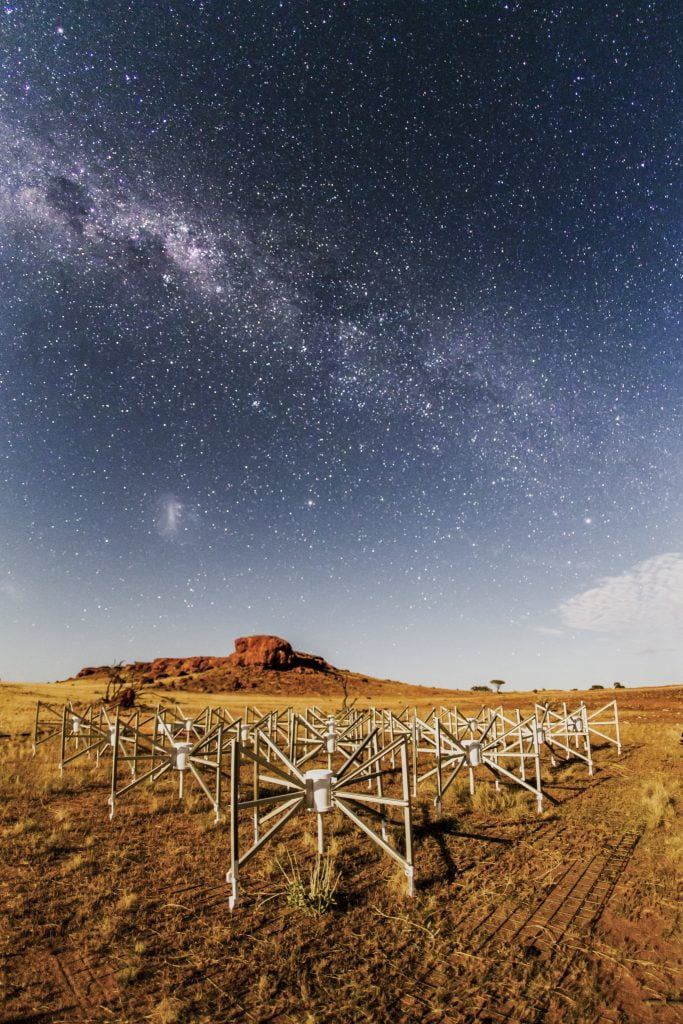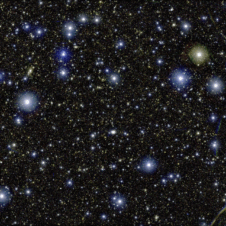
The Murchison Widefield Array (MWA) is a low frequency radio telescope and is the first of four Square Kilometre Array (SKA) precursors to be completed.
Two outback radio telescopes synchronised to observe the same point of sky have discovered more about one of the Universe’s most mysterious events in new research published today.
The Curtin University-led Murchison Widefield Array (MWA) and CSIRO’s Australian SKA Pathfinder (ASKAP) telescopes were searching the sky for fast radio bursts, which are exceptionally bright flashes of energy coming from deep space.
These extreme events last for only a millisecond but are so bright that many astronomers initially dismissed the first recorded fast radio burst as an observational error.
In research published in the Astrophysical Journal Letters, astronomers describe how ASKAP detected several extremely bright fast radio bursts, but the MWA—which scans the sky at lower frequencies—did not see anything, even though it was pointed at the same area of sky at the same time.
Lead author Dr Marcin Sokolowski, from the Curtin University node of the International Centre for Radio Astronomy Research (ICRAR), said the fact that the fast radio bursts were not observed at lower frequencies was highly significant.
“When ASKAP sees these extremely bright events and the MWA doesn’t, that tells us something really unexpected is going on; either fast radio burst sources don’t emit at low frequencies, or the signals are blocked on their way to Earth,” Dr Sokolowski said.
A fast radio burst leaves a distant galaxy, travelling to Earth over billions of years and occasionally passing through clouds of gas in its path. Each time a cloud of gas is encountered, the different wavelengths that make up a burst are slowed by different amounts. Timing the arrival of the different wavelengths at a radio telescope tells us how much material the burst has travelled through on its way to Earth and allows astronomers to to detect “missing” matter located in the space between galaxies. Credit: CSIRO/ICRAR/OzGrav/Swinburne University of Technology
Study co-author Dr Ramesh Bhat, who is also based at ICRAR-Curtin, said it required considerable co-ordination to get the CSIRO-led ASKAP telescope and Curtin-led MWA telescope pointed at the same area of sky at the same time.
Both telescopes were able to capture the same view because the two telescopes are located side-by-side in the desert of Western Australia’s remote Murchison region.
“Fast radio bursts are unpredictable, so to catch them when both telescopes are looking in the same direction isn’t easy,” Dr Bhat said.
“It took many months of ASKAP and the MWA co-tracking the same area of sky, ensuring the best overlap of their views possible, to give us the chance at catching some of these enigmatic bursts.
“The challenge was in making it all happen automatically, but it really paid off.”
ICRAR-Curtin astronomer Dr Jean-Pierre Macquart, also a co-author of the research, said fast radio bursts have perplexed astronomers ever since the first burst was discovered in 2007.
“It’s really thrilling to have a clue about the origins of these incredible bursts of energy from outside our galaxy,” Dr Macquart said.
“The MWA adds an important piece of the puzzle and it was only made possible with this ‘technological tango’ between the two telescopes.
“It’s an exciting development because it unites the two teams and it brings home the advantage of having the two telescopes at the same site.
“Future coordination between the teams will also benefit other areas of astronomy, as complementary views from the two telescopes can provide a more complete picture of a situation.”
Original Publication
‘No low-frequency emission from extremely bright Fast Radio Bursts’, published in Astrophysical Journal Letters on October 29th, 2018.
More Information
The MWA
The Murchison Widefield Array (MWA) is a low frequency radio telescope and is the first of four Square Kilometre Array (SKA) precursors to be completed.
A consortium of partner institutions from seven countries (Australia, USA, India, New Zealand, Canada, Japan, and China) financed the development, construction, commissioning, and operations of the facility. The MWA consortium is led by Curtin University.
ICRAR
The International Centre for Radio Astronomy Research (ICRAR) is a joint venture between Curtin University and The University of Western Australia with support and funding from the State Government of Western Australia.
Multimedia
If you require imagery and video content for media purposes, please email kirsten.gottschalk@icrar.org.

Tile 107, or “the Outlier” as it is known, is one of 128 original tiles of the MWA located 1.5km from the core of the telescope. Lighting the tile and the ancient landscape is the Moon. Photographed by Pete Wheeler, ICRAR.

Left: An aerial view of CSIRO’s Australian SKA Pathfinder (ASKAP). Credit: CSIRO
Right: An aerial view showing some of of the 256 “tiles” belonging to the Murchison Widefield Array. Credit: ICRAR
A time-lapse sequence of more than 1,000 images captured at the Murchison Radio-astronomy Observatory in Mid West WA. Tile 107, or “the Outlier” as it is known, is one of 128 original tiles of the MWA, located 1.5km from the core of the telescope. Lighting the tile and the ancient landscape is the Moon. Credit: Pete Wheeler, ICRAR.

An artist’s impression of CSIRO’s ASKAP radio telescope detecting a fast radio burst (FRB). Scientists don’t know what causes FRBs but it must involve incredible energy—equivalent to the amount released by the Sun in 80 years. Credit: OzGrav, Swinburne University of Technology.
The Murchison Widefield Array (MWA) is a low frequency radio telescope and is the first of four Square Kilometre Array (SKA) precursors to be completed. A consortium of partner institutions from seven countries (Australia, USA, India, New Zealand, Canada, Japan, and China) financed the development, construction, commissioning, and operations of the facility. The MWA consortium is led by Curtin University.

An artist’s impression of fast radio bursts (FRBs). An Australian team of researchers has shown that the brighter FRBs, discovered using CSIRO’s ASKAP radio telescope, are probably in galaxies that are quite nearby, while fainter ones (found previously) are likely to be much more distant. Credit: OzGrav, Swinburne University of Technology.
Contacts
Dr Marcin Sokolowski (ICRAR / Curtin University)
Ph: +61 8 9266 2046 E: Marcin.Sokolowski@icrar.org
Kirsten Gottschalk (Media Contact, ICRAR)
Ph: +61 438 361 876 E: kirsten.gottschalk@icrar.org
Lucien Wilkinson (Media Contact, Curtin University)
Ph: +61 401 103 683 E: Lucien.Wilkinson@curtin.edu.au

